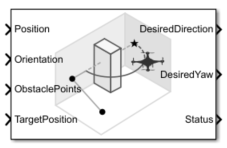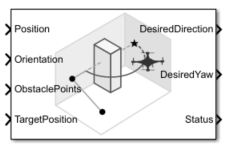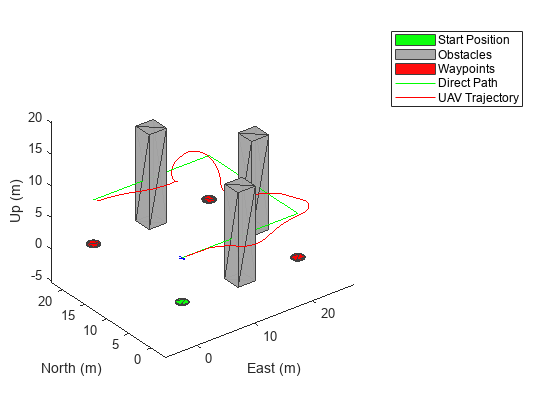Obstacle Avoidance
Compute obstacle-free direction using range sensor data and target position
Since R2021b

Libraries:
UAV Toolbox /
Algorithms
Description
The Obstacle Avoidance block computes an obstacle-free direction using range sensor data and target position.
Examples
Ports
Input
Position — Position of UAV
vector
Position of the UAV, specified as a vector of the form
[x; y;
z]. x,
y, and
z define the xyz-position of the UAV in any
right-handed coordinate frame, such as NED and ENU. Units are in meters.
Example:
[1; 1; 1]
Data Types: double
Orientation — Orientation of UAV
vector
Orientation of the UAV, specified as a quaternion vector of the form
[w; x; y;
z].
Example: [1; 0; 0; 0]
Data Types: double
ObstaclePoints — Positions of obstacles
matrix
Positions of the obstacles, specified as an N-by-3 matrix with
rows of the form [x
y
z]. x,
y, and
z define the xyz-position of the obstacle
point in the reference frame of the range sensor. N is the number
of obstacle points. Units are in meters.
Example: [1 1 1; 2 2 2]
Data Types: double
TargetPostion — Position of target
vector
Position of the target, specified as a vector of the form
[x; y;
z]. x,
y, and
z define the xyz-position of the target in any
right-handed coordinate frame. Units are in meters.
Example: [2; 3; 4]
Data Types: double
Output
DesiredDirection — Desired direction
vector
Desired direction, returned as a unit vector of the form
[x; y;
z]. x,
y, and
z define the desired direction in the
right-handed coordinate frame that you specified in the position input. Units are in
meters.
Data Types: double
DesiredYaw — Desired yaw
scalar
Desired yaw, returned as numeric scalar in radians in the range of [-pi,
pi].
Data Types: double
Status — Status of obstacle-free direction
0 | 1 | 2 | 3
Status of the obstacle-free direction, returned as 0,
1, 2, or 3.
0— An obstacle-free direction is found.1— No obstacle-free direction is found.2— An obstacle-free direction is found but is close to the obstacle.3— No obstacle-free direction is found and is close to obstacle.
Data Types: uint8
Parameters
Sensor range limits (m) — Limits of range sensor
[0.2 10] (default) | vector of form [min
max]
Specify the minimum and maximum limits of the range sensor as a vector of the form
[min
max], with values in meters.
Data Types: double
Sensor horizontal field of view (deg) — Horizontal field of view limits of range sensor
[-60 60] (default) | vector of form [min
max]
Specify the minimum and maximum horizontal field of view limits of the range sensor
as a vector of the form [min
max], with values in degrees.
Data Types: double
Sensor vertical field of view (deg) — Vertical field of view limits of range sensor
[-30 30] (default) | vector of form [min
max]
Specify the minimum and maximum vertical field of view limits of the range sensor as
a vector of the form [min
max], with values in degrees.
Data Types: double
Sensor location [X, Y, Z] (m) — Sensor mounting location on UAV
[0 0 0] (default) | vector of form [x
y
z]
Specify the mounting location of the sensor on the UAV as a vector of the form
[x
y
z], with values in meters.
Data Types: double
Sensor orientation [Roll, Pitch, Yaw] (deg) — Orientation of sensor mounted on UAV
[0 0 0] (default) | vector of form [roll
pitch
yaw]
Specify the orientation of the sensor mounted on the UAV as a vector of the form
[roll
pitch
yaw], with values in degrees.
Data Types: double
Vehicle radius (m) — Radius of UAV
1 (default) | numeric scalar
This dimension defines the smallest circle that can circumscribe your vehicle, in meters. The vehicle radius is used to account for vehicle size when computing the obstacle-free direction.
Data Types: double
Minimum distance to obstacle (m) — Safety distance around UAV to obstacle
1 (default) | numeric scalar
The safety distance specifies, in meters, the space accounted for between the UAV and obstacles in addition to the vehicle radius. The vehicle radius and safety distance are used to compute the obstacle-free direction.
Data Types: double
Simulate using — Type of simulation to run
Interpreted execution (default) | Code generation
Specify whether to simulate the model using Interpreted execution
or Code generation.
Interpreted execution— Simulate the model using the MATLAB® interpreter. This option reduces startup time, but has a slower simulation speed thanCode generation. In this mode, you can debug the source code of the block.Code generation— Simulate the model using generated C code. The first time you run a simulation, Simulink® generates C code for this block. The C code is reused for subsequent simulations, as long as the model does not change. This option requires additional startup time, but the speed of subsequent simulations is faster thanInterpreted execution.
Tunable: No
Histogram resolution (deg) — Histogram grid resolution
5 (default) | 1 | 3 | 6 | 10 | 15 | 18 | 30 | 45 | 60
To change the histogram grid resolution, select a value from the list. All values are in degrees.
Histogram window size — Histogram window size
1 (default) | odd integer
The histogram window size determines the angular width of an obstacle-free opening in the azimuth and elevation directions. This value is unitless.
Data Types: uint8
Histogram threshold — Threshold for computing histogram
1 (default) | positive integer
The threshold for computing the histogram specifies the minimum number of obstacle points that should be in an histogram cell to be considered as obstacle. If a cell contains fewer than this number of obstacle points, the cell is considered as obstacle-free.
Data Types: uint8
Maximum age of obstacle point — Maximum age of remembered obstacle point
0 (default) | numeric scalar
Specifies the maximum age of a remembered obstacle point as a numeric scalar. This value specify the number of previous time steps for which the obstacle points from those time steps is remembered.
Data Types: double
Target direction weight — Cost function weight for target direction
5 (default) | numeric scalar
Specifies the function weight for moving toward the target direction. To follow a
target direction, set this weight to be greater than the sum of Current direction
weight and Previous direction
weight. To ignore the target direction cost, set this weight to
0.
Data Types: double
Current direction weight — Cost function weight for current direction
2 (default) | numeric scalar
Specifies the function weight for moving the vehicle in the current heading
directions. Higher values of this weight produce efficient paths. To ignore the current
direction cost, set this weight to 0.
Data Types: double
Previous direction weight — Cost function weight for previous direction
2 (default) | numeric scalar
Specifies the function weight for moving in the previously selected steering
direction. Higher values of this weight produce smoother paths. To ignore the previous
direction cost, set this weight to 0.
Data Types: double
Extended Capabilities
C/C++ Code Generation
Generate C and C++ code using Simulink® Coder™.
Version History
Introduced in R2021b
See Also
MATLAB Command
You clicked a link that corresponds to this MATLAB command:
Run the command by entering it in the MATLAB Command Window. Web browsers do not support MATLAB commands.

Select a Web Site
Choose a web site to get translated content where available and see local events and offers. Based on your location, we recommend that you select: .
You can also select a web site from the following list:
How to Get Best Site Performance
Select the China site (in Chinese or English) for best site performance. Other bat365 country sites are not optimized for visits from your location.
Americas
- América Latina (Español)
- Canada (English)
- United States (English)
Europe
- Belgium (English)
- Denmark (English)
- Deutschland (Deutsch)
- España (Español)
- Finland (English)
- France (Français)
- Ireland (English)
- Italia (Italiano)
- Luxembourg (English)
- Netherlands (English)
- Norway (English)
- Österreich (Deutsch)
- Portugal (English)
- Sweden (English)
- Switzerland
- United Kingdom (English)

